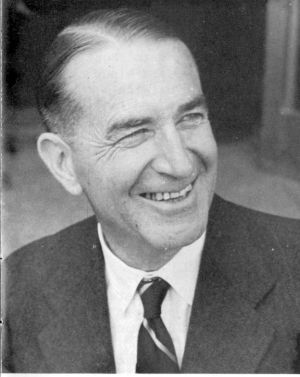Phyl Bennett – the Barwick Years and Reflections
Mr Barwick brought back to the school the same sense of scholastic enthusiasm that had been the keynote of its, first Headmaster, with an exceptional range as a reader and a quick sense of intellectual and social change. His outdoor relaxation was fishing, so he haunted our beaches. A rapid organiser, he could sit in his office absorbed in the latest reading, yet never refuse a call for assistance, guidance or just plain encouragement. His memory was as phenomenal as his powers of concentration and relaxation, and he often surprised by a quotation from a book read years ago. He retired to Terrigal, but he and his wife now live on the waterfront in Gosford.
After Hec Egger left to be Principal of Wyong High, Mr Barwick’s deputies were first Tom 0′Gorman and then Leo Hickey who had been English Master here and finally John Holmes, long associated with the school as football coach and Science Master. His family, too, were educated here.
I must record one of the most pleasant functions I have ever attended, a reunion arranged by the first leaving certificate class to have Mr Barwick as Headmaster. He, I and Hec Egger were their special guests at Terrigal and you can imagine our pride in seeing these young citizens and meeting their wives and husbands, all people between 28 and 30. Maureen Reynolds (as she had been) met me at the door saying “We have all worn our best cotton dresses as we did for the frolics and we made them ourselves”. It was a charming reminder of how I used to endeavour to keep them from outsmarting each other, and they hadn’t forgotten.
By 1956 Mr Barwick’s staff consisted of his deputy, Mr Egger, five subject masters, Mrs Ewers a S.S.A. in charge of Home Science, a District Counsellor (Don Taylor) three sports teachers, myself, still supervisor of girls and other teachers of a wide range of subjects – fifty six teachers in all.
Obviously the school was rapidly outgrowing itself and an annex was formed opposite the Golf Links, just below the northern slopes of President’s Hill. This was to grow into Gosford’s second High School, Vic Cooke being the first Principal. I was seconded to Sydney Teachers’ College in 1960, but the district as I once knew it is now served by High Schools at Wyong, Umina, Woy Woy, Erina, The Entrance, Morisset, Gorokan and finally Terrigal. It is not suprising since what was once a rural agricultural area, fringed by holiday resorts, has become a dormitory suburb for commuters with its own rapidly growing industrial areas.
Fortunately the sea and the broken mountainous barrier to the west are holding off exploiters, a keen historical society keeps its history before us, and the school, through those who served it and serve it still, is very much alive. Its vitality comes not only from those distinguished people we mention with pride. Those of us who have attended local reunions of students have rejoiced especially to see the homemakers and parents of many of the present pupils. Their warmth towards the school and its successive staffs and their sense of having shared a common experience in youth, are pleasant things.
The present extent of the school is a joy to those of us who battled so long for two things: a wider curriculum to make an attempt to catch up with modern knowledge and living requirements and facilities of social, sporting and cultural activities. I think of Mr Stoyles and the battle to get the library, of Mr Gibson becoming an Alderman (we were a municipality for some years) to fight for playing fields on Crown land near the school, of our constantly defeated hopes for an assembly hall.
Gosford High School was always to be a driving force through the personality of that first Headmaster and the warmth he aroused in a little country town which wished its children to be educated within reach of their homes, boys and girls in the one community. Some of us struggled for years to have this concept widely accepted and to make comprehensive schools work. When they do, we feel very proud and well rewarded for having persisted, often against our own immediate advancement, in a course in which we believed. We believed, too, that the publishing of the results of public examination was one of the greatest correctives to the belief that state schools could not compete with private establishments. They could, they did. The false idea is on the rise again. Let the results again be published in a form the public can-comprehend. Let us be judged by what we do, not only in sport where comparisons are so open to all, but in scholarship and citizenship.
Back to The War and Depression Years
The school history section of this site is from the publication Looking Back 1929 to 1979 for the 50th centenary of the school. The publication was produced by the student committee – Tony Lamb, Sue Wishart, Chris Bell, Karen Chapman, Cathy Hughes with support from then History Mistress Mrs Elizabeth Ferguson and support an photography assistance from then Headmaster Mr Peter Feilen.


